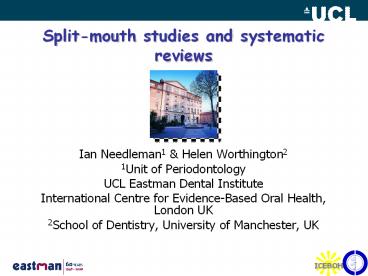Split-mouth studies and systematic reviews the analysi - PowerPoint PPT Presentation
1 / 18
Title:
Split-mouth studies and systematic reviews the analysi
Description:
Split-mouth studies and systematic reviews the analysis issue ... Authors of systematic reviews: please state explicitly how data from split-mouth ... – PowerPoint PPT presentation
Number of Views:123
Avg rating:3.0/5.0
Title: Split-mouth studies and systematic reviews the analysi
1
Split-mouth studies and systematic reviews
- Ian Needleman1 Helen Worthington2
- 1Unit of Periodontology
- UCL Eastman Dental Institute
- International Centre for Evidence-Based Oral
Health, London UK - 2School of Dentistry, University of Manchester, UK
2
Split-mouth studies and systematic reviews
- What is the issue?
- Why include them?
- How to include them
- Examples
3
Split-mouth studies and systematic reviews the
analysis issue
- As we know, the analysis of split-mouth and
parallel group studies is not the same. - As a result, if a meta-analysis includes both
types of trials without considering the
differences, the result might be unreliable - The confidence interval will be incorrect,
possibly leading to - An inappropriate conclusion on clinical
importance (and statistical significance) - Distortion of impact of clinical heterogeneity
4
Why include split-mouth studies in systematic
reviews?
- Because of the totality of the evidence
- Possible advantages of split-mouth trials over
parallel group - Each participant acts as own control
- Therefore, fewer participants are required to
obtain same study power as parallel group - Every participant receives each intervention,
therefore good for determining preferences
5
How to include split-mouth studies in systematic
reviews
- Designing the systematic review
- Is split-mouth an appropriate design to answer
this question? - Are carry-over effects a risk?
6
How to include split-mouth studies in systematic
reviews
- Conducting the systematic review
- Fundamental question Is meta-analysis justified
in principle? - Are the trials similar enough in chief
characteristics - Types of populations
- Types of interventions
- Types of outcomes
7
How to include split-mouth studies in systematic
reviews
- Possible ways
- Narrative (qualitative) summary in evidence
tables only. - Advantage split-mouth studies contribute to
totality of evidence and analytic issues (may be)
avoided - Disadvantage Do not contribute to summary
estimate or to investigation of heterogeneity - Analyse as if parallel group
- Not recommended due to potentially unreliable
meta-analysis summary estimate
?
8
How to include split-mouth studies in systematic
reviews
- Possible ways
- Meta-analyse those split-mouth trials with
adequate data separately from parallel group
trials and ignore those without such data - Advantage More information
- Disadvantage Selection bias
- Incorporate data from first intervention side if
reported separately - Advantage More information
- Disadvantage May be biased sample where
trialists identified carry-over effects
9
How to include split-mouth studies in systematic
reviews
- Possible ways
- Approximate a paired analysis by inputing a
measure describing the similarity of outcomes
within each participant. - Advantages Makes use of all trials
- Disadvantages
- May make assumptions about data (that can be
tested) - May need statistical support
10
Approximating a paired analysis - you will need
one of the following
- Individual patient data in publication or from
contact with trialist - Mean and SD/SE of patient specific differences
between intervention A and B measurement
11
Approximating a paired analysis - you will need
one of the following
- Mean difference (or difference between means) and
one of - t-statistic (paired t-test)
- P-value from paired t-test
- Confidence interval from paired analysis
- Graph of measurement of intervention A and B from
which matched individual data values can be
extracted.
12
Approximating a paired analysis
- Step one. Calculate the correlation coefficient
(r) for each study. - The correlation coefficient describes how similar
the measurement of intervention A and B were
within a participant - Assumes that mean and SD for each intervention
treatment side/period would be the same - If r is inconsistent between studies, then
caution on proceeding further. - If r cannot be calculated for a trial, use
representative value from other trials as the
trials should be very similar for a particular
intervention in a systematic review
13
Approximating a paired analysis
- Step two. Calculate SE of the mean difference
between the interventions - Step three. Enter the data into meta-analysis
software. Generic inverse variance method of
Cochrane Software - RevMan - particularly
flexible (free download). - Step four. Conduct sensitivity analyses employing
different values for r to investigate robustness
of estimates especially for studies were r could
not be calculated
14
How to include split-mouth studies in systematic
reviews
- Further issues
- Generally advisable to meta-analyse split-mouth
and parallel group trials separately as
sub-groups to investigate systematic differences - Authors of systematic reviews please state
explicitly how data from split-mouth studies has
been managed
15
How to include split-mouth studies in systematic
reviews
- Example of meta-analysis of split mouth and
parallel group trials.
16
Needleman, Worthington, Giedrys-Leeper, Tucker
2006, Cochrane Database of Systematic Reviews
17
Split-mouth studies and systematic reviews
- Conclusions
- Split-mouth studies should be included in
systematic reviews when appropriate - It is possible to combine split-mouth and
parallel group studies in meta-analysis - Our observation within the Cochrane Oral Health
Group is that differences in effect sizes exist
between split-mouth and parallel group studies of
the same intervention
18
Split-mouth studies and systematic reviews
- Resources
- Cochrane Handbook and RevMan www.cochrane.org
- Elbourne et al. 2002. Int J Epidem, 31 140-149
- Follman et al. 1992. J Clin Epidem, 45 769-773
- Contact i.needleman_at_eastman.ucl.ac.uk































